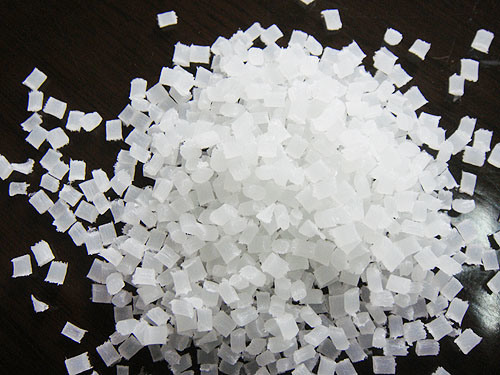Úvod: Všestrannosť a použitie Nylon 6 PA6
Nylon 6 PA6 je semikryštalický polymér známy svojou všestrannosťou a širokým využitím v priemyselných odvetviach, ako je automobilový priemysel, elektronika a textil. V tomto článku sa podrobne skúma proces jeho výroby, pričom sa zdôrazňujú jednotlivé kroky od jeho chemického pôvodu až po konečnú podobu.
Syntéza kaprolaktámu: Základ nylonu 6
Výroba nylonu 6 PA6 sa začína syntézou jeho kľúčovej zložky, kaprolaktámu. Kaprolaktám sa získava z oxidu cyklohexánu, ktorý podlieha hydrolýze. Tento proces zahŕňa oxidáciu cyklohexánu, po ktorej nasleduje reakcia s vodou, pričom vzniká kaprolaktám, základný prekurzor nylonu 6.
Polymerizácia: Premena kaprolaktámu na nylon 6
Vo fáze polymerizácie prechádzajú molekuly kaprolaktámu chemickou reakciou za prítomnosti katalyzátora, ako je hydroxid sodný alebo kyselina sírová. Táto reakcia prebieha mechanizmom polymerizácie s otvorením kruhu, pričom sa kaprolaktámové monoméry spájajú do dlhých lineárnych polymérnych reťazcov, čo vedie k vzniku nylonu 6. Tento krok je rozhodujúci pre vytvorenie polyméru s vynikajúcimi mechanickými vlastnosťami a chemickou odolnosťou.
Miešanie pre zlepšenie vlastností: Kombinácia nylonu 6 a PA66
Na zlepšenie rázovej pevnosti a tepelnej odolnosti nylonu 6 sa často mieša s polyamidom 66 (PA66). Proces miešania zahŕňa miešanie nylonu 6 s PA66 v reaktore, pričom sa využíva ich chemicky podobný, ale odlišný bod topenia. Tým sa vytvorí dvojfázová štruktúra, v ktorej sú oba polyméry oddelené, ale vzájomne prepojené, čo zlepšuje celkové vlastnosti výslednej zmesi Nylonu 6 a PA6.
Vytláčanie: Tvarovanie konečného výrobku
Posledným krokom pri výrobe je vytláčanie. V tejto fáze sa zmiešaná zmes Nylonu 6 PA6 zahrieva a pretláča cez lisovací stroj, aby sa vytvarovala do požadovanej formy. Tento vytlačený výrobok sa potom ochladí, nareže a ďalej spracuje tak, aby spĺňal špecifické požiadavky na použitie, či už v automobilových komponentoch, elektronických súčiastkach alebo na iné účely.
Záver
Jeho výroba je mnohostranný proces, ktorý zahŕňa syntézu kaprolaktámu, jeho polymerizáciu na nylon 6, miešanie s PA66 a vytláčanie do konečných výrobkov. Každý krok je neoddeliteľnou súčasťou vývoja jedinečných vlastností, ktoré z neho robia cenný materiál v rôznych priemyselných odvetviach. Pochopením tohto zložitého výrobného procesu získame hlbší pohľad na jeho všestrannosť a funkčnosť.
Nylon 6 PA6 Často kladené otázky: Váš komplexný sprievodca
Čo je nylon 6 PA6?
Nylon 6 PA6, známy aj ako nylon 6/6, je semikryštalický polymér široko využívaný v rôznych priemyselných odvetviach pre svoje výnimočné mechanické vlastnosti a chemickú odolnosť. Vzniká polymerizáciou kaprolaktámu s možným miešaním s Polyamid 66 (PA66) na zlepšenie jeho vlastností.
Ako sa vyrába nylon 6 PA6?
Proces jeho výroby zahŕňa niekoľko kľúčových krokov:
- Syntéza kaprolaktámu:Oxid cyklohexánu sa hydrolyzuje za vzniku kaprolaktámu.
- Polymerizácia:Kaprolaktám podlieha polymerizácii v prítomnosti katalyzátora, pričom vzniká nylon 6.
- Miešanie:Nylon 6 sa môže miešať s PA66, aby sa zlepšili jeho vlastnosti.
- Vytláčanie:Zmiešaná zmes sa vytlačí do požadovaného tvaru.
Aké sú vlastnosti nylonu 6 PA6?
Vykazuje vynikajúce mechanické vlastnosti, chemickú odolnosť a tepelnú stabilitu. Je známy svojou vysokou pevnosťou v ťahu, trvanlivosťou a odolnosťou voči nárazom, vďaka čomu je vhodný na širokú škálu aplikácií.
Aké sú aplikácie nylonu 6 PA6?
Nachádza uplatnenie v rôznych priemyselných odvetviach vrátane automobilového, elektronického, textilného a spotrebného tovaru. Vďaka svojej univerzálnosti a výkonnosti sa používa v automobilových súčiastkach, elektrických konektoroch, priemyselných komponentoch, odevoch a predmetoch pre domácnosť.
Prečo je nylon 6 PA6 zmiešaný s PA66?
Zmiešaním nylonu 6 s PA66 sa zlepšujú jeho vlastnosti, ako napríklad rázová pevnosť a tepelná odolnosť. Dvojfázová štruktúra vytvorená zmiešaním umožňuje jedinečnú rovnováhu vlastností, čo z neho robí ideálny materiál pre rôzne aplikácie.
Ako proces vytláčania prispieva k výrobe nylonu 6 PA6?
Vytláčanie je posledným krokom výroby, pri ktorom sa zmes vytvaruje do požadovanej formy. Tento proces zabezpečuje rovnomernosť a presnosť výroby, čo umožňuje vytvárať výrobky na mieru prispôsobené špecifickým požiadavkám aplikácie.
Aké sú environmentálne aspekty výroby nylonu 6 PA6?
Jeho výroba zahŕňa chemické procesy a spotrebu energie. Pokroky v recyklačných technológiách a udržateľné postupy však majú za cieľ minimalizovať vplyv na životné prostredie. Spoločnosti neustále inovujú s cieľom znížiť množstvo odpadu a spotrebu energie pri jeho výrobe.
Kde sa môžem dozvedieť viac o nylone 6 PA6 a jeho aplikáciách?
Ďalšie informácie o nylone 6 PA6 a jeho aplikáciách nájdete v priemyselných publikáciách, môžete sa poradiť s výrobcami alebo navštíviť veľtrhy a výstavy zamerané na materiály a polyméry. Okrem toho online zdroje a technické dokumenty poskytujú podrobné informácie o jeho vlastnostiach a použití.
Aký budúci vývoj môžeme očakávať pri výrobe nylonu 6 PA6?
Budúci vývoj v oblasti jeho výroby sa môže zamerať na zvýšenie udržateľnosti, zlepšenie výkonu a rozšírenie aplikácií. Výskum a inovácie sú naďalej hnacou silou pokroku v oblasti chémie polymérov, techník spracovania a konštrukcie materiálov, čo formuje budúcnosť tohto všestranného a udržateľného materiálu.
Kto sú poprední výrobcovia nylonu 6 PA6?
Poprední výrobcovia nylonu 6 PA6 patria veľké chemické spoločnosti a výrobcovia polymérov s odbornými znalosťami v oblasti polymerizácie a technológií výroby zmesí. Tieto spoločnosti ho dodávajú na celom svete, aby splnili požiadavky rôznych priemyselných odvetví a aplikácií.

